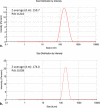Simvastatin-Loaded Lipid Emulsion Nanoparticles: Characterizations and Applications
- PMID: 35847279
- PMCID: PMC9280776
- DOI: 10.1021/acsomega.2c02242
Simvastatin-Loaded Lipid Emulsion Nanoparticles: Characterizations and Applications
Abstract
Simvastatin (SIM) is a diet drug to treat high lipid levels in the blood. It has the drawback of being metabolized in humans' gastrointestinal tract (GIT) when taken in an oral dosage form. To enhance the role of SIM in treating hyperlipidemias and bypassing its metabolism in GIT, a biodegradable nanocarrier as a SIM-loaded lipid emulsion nanoparticle via the solvent injection method was designed. Cholesterol acts as a lipid core, and Tween 80 was utilized to stabilize the core. The optimized nanoformulation was characterized for its particle diameter, zeta potential, surface morphology, entrapment efficiency, crystallinity, and molecular interaction. Furthermore, the transdermal hydrogel was characterized by physical appearance, rheology, pH, and spreadability. In vitro assays were executed to gauge the potential of LENPs and olive oil for transdermal delivery. The mean particle size and zeta potential of the optimized nanoparticles were 174 nm and -22.5 mV 0.127, respectively. Crystallinity studies and Fourier transform infrared analyses revealed no molecular interactions. Hydrogels showed a sustained release compared to SIM-loaded LENPs that can be proposed as a better delivery system for SIM. We encourage further investigations to explore the effect of reported formulations for transdermal delivery by in vivo experiments.
© 2022 The Authors. Published by American Chemical Society.
Conflict of interest statement
The authors declare no competing financial interest.
Figures












References
-
- Nagraik R.; Sharma A.; Kumar D.; Mukherjee S.; Sen F.; Kumar A. P. Amalgamation of biosensors and nanotechnology in disease diagnosis: Mini-review. Sens. Int. 2021, 2, 100089.10.1016/j.sintl.2021.100089. - DOI
-
- Patra J. K.; Das G.; Fraceto L. F.; Campos E. V. R.; Rodriguez-Torres M. d. P.; Acosta-Torres L. S.; Diaz-Torres L. A.; Grillo R.; Swamy M. K.; Sharma S.; et al. Nano based drug delivery systems: recent developments and future prospects. J. Nanobiotechnol. 2018, 16, 71.10.1186/s12951-018-0392-8. - DOI - PMC - PubMed
LinkOut - more resources
Full Text Sources

